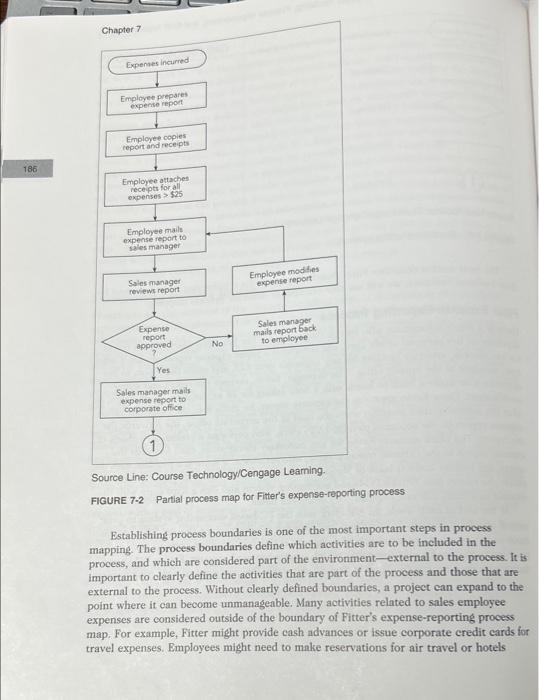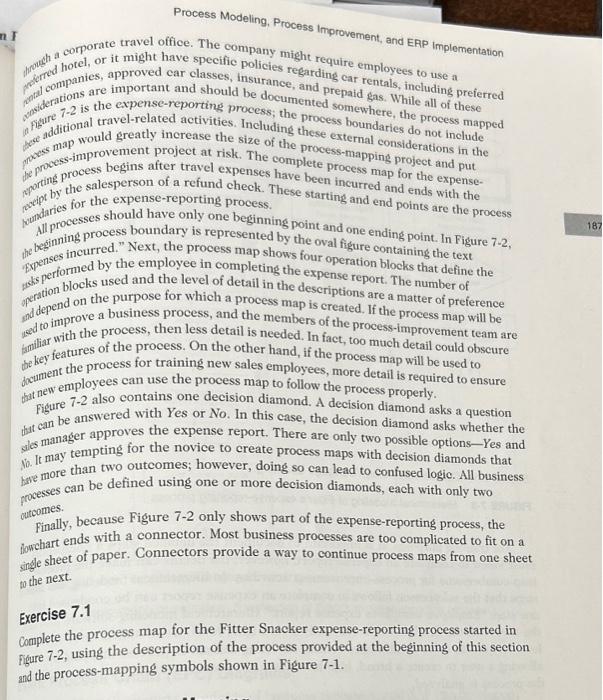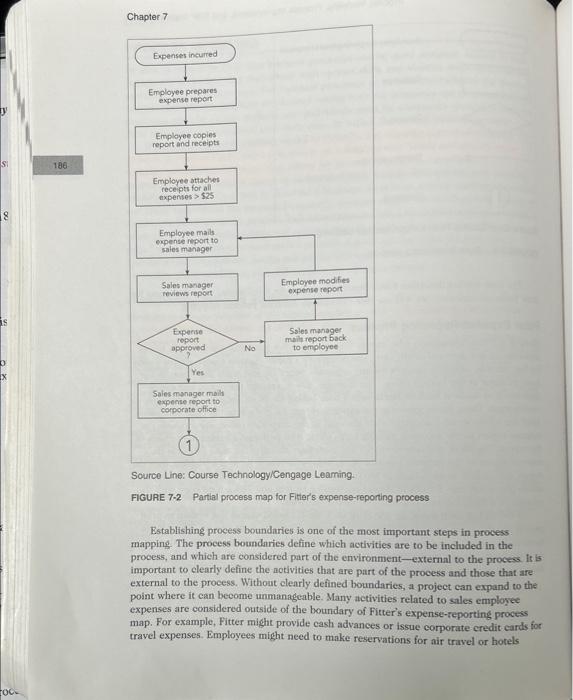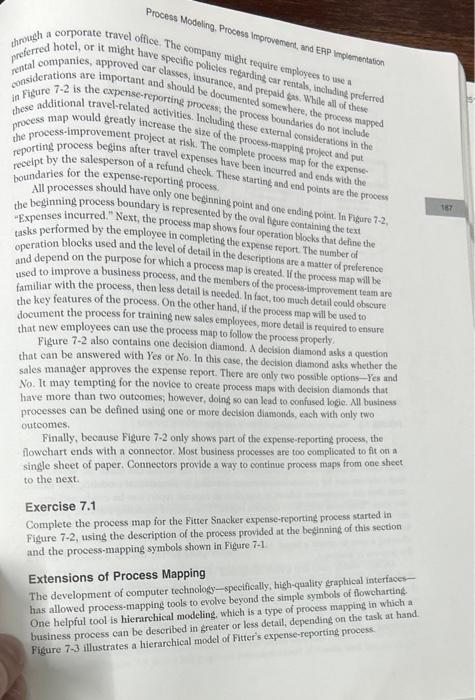Answered step by step
Verified Expert Solution
Question
1 Approved Answer
186 Chapter 7 Expenses incurred Employee prepares expense report Employee copies report and receipts Employee attaches receipts for all expenses > $25 Employee mails





186 Chapter 7 Expenses incurred Employee prepares expense report Employee copies report and receipts Employee attaches receipts for all expenses > $25 Employee mails expense report to sales manager Sales manager reviews report Employee modifies expense report Expense report approved Yes Sales manager mails expense report to corporate office No Sales manager mails report back to employee Source Line: Course Technology/Cengage Learning. FIGURE 7-2 Partial process map for Fitter's expense-reporting process Establishing process boundaries is one of the most important steps in process mapping. The process boundaries define which activities are to be included in the process, and which are considered part of the environment-external to the process. It is important to clearly define the activities that are part of the process and those that are external to the process. Without clearly defined boundaries, a project can expand to the point where it can become unmanageable. Many activities related to sales employee expenses are considered outside of the boundary of Fitter's expense-reporting process map. For example, Fitter might provide cash advances or issue corporate credit cards for travel expenses. Employees might need to make reservations for air travel or hotels through preferred hotel, Process Modeling, Process Improvement, and ERP Implementation a corporate travel office. The company might require employees to use a , or it might have specific policies regarding car rentals, including preferred rental companies, approved c nsiderations are important and should be documented somewhere, the process mapped in Figure 7-2 is the expense-reporting process; the process boundaries do not include process map would greatly increase the size of the process-mapping project and put hese additional travel-related activities. Including these external considerations in the reporting process begins after travel expenses have been incurred and ends with the receipt by the salesperson of a refund check. These starting and end points are the process the process-improvement project at risk. The complete process map for the expense- boundaries for the expense-reporting process. All processes should have only one beginning point and one ending point. In Figure 7-2, the beginning process boundary is represented by the oval figure containing the text "Expenses incurred." Next, the process map shows four operation blocks that define the operation blocks used and the level of detail in the descriptions are a matter of preference sks performed by the employee in completing the expense report. The number of and depend on the purpose for which a process map is created. If the process map will be used to improve a business process, and the members of the process-improvement team are familiar with the process, then less detail is needed. In fact, too much detail could obscure the key features of the process. On the other hand, if the process map will be used to document the process for training new sales employees, more detail is required to ensure that new employees can use the process map to follow the process properly. car classes, insurance, and prepaid gas. While all of these Figure 7-2 also contains one decision diamond. A decision diamond asks a question that can be answered with Yes or No. In this case, the decision diamond asks whether the sales manager approves the expense report. There are only two possible options-Yes and No. It may tempting for the novice to create process maps with decision diamonds that have more than two outcomes; however, doing so can lead to confused logic. All business processes can be defined using one or more decision diamonds, each with only two outcomes. Finally, because Figure 7-2 only shows part of the expense-reporting process, the flowchart ends with a connector. Most business processes are too complicated to fit on a single sheet of paper. Connectors provide a way to continue process maps from one sheet to the next. Exercise 7.1 Complete the process map for the Fitter Snacker expense-reporting process started in Figure 7-2, using the description of the process provided at the beginning of this section and the process-mapping symbols shown in Figure 7-1. 187 1000 Process Modeling, Process Improvement, and ERP implementation Boundaries (beginning end of proces Operation Decision Direction of logic 1 Connector Source Line: Course Technology/Cengage Leaming FIGURE 7-1 Basic flowcharting symbols their business expenses; we will use this example to illustrate process mapping The next section describes Fitter Snacker's process for reimbursing sales personnel for Fitter Expense-Reporting Process Maria is a Fitter salesperson who travels frequently for her job. After Maria incurs travel expenses on her personal credit card, she completes a paper expense report, makes a copy for her records, attaches receipts for any expenses over $25, and mails the report to her zone manager at the branch office. The manager, Kevin, reviews the report and either approves it or mails it back to Maria with a note asking for an explanation, verification, or modification. Once Kevin approves the expense report, he mails it to the corporate office. After the administrative assistant sorts the mail at the corporate office, she forwards the expense report to the accounts payable (AP) clerk, who performs a preliminary check of the report. The clerk contacts Kevin for any necessary clarification, then forwards the expense report to the expense report auditor, who reviews it. If there is a problem with the report, the auditor mails it back to Maria, who revises it and returns it. Then the auditor enters the report into Fitter's PC-based accounting system and files a hard copy with the receipts in a filing cabinet, organized by employee name. At the end of each week, an A/P clerk uses the PC-based accounting system to print payroll checks, payments to suppliers, and expense reimbursement checks. When Maria receives her reimbursement check, she deposits it into her checking account and mails a payment to the credit card company, which credits her card account. Figure 7-2 shows the process map for the first part of the current Fitter Snacker expense-reporting process 185 y S 186- 8 S Chapter 7 Expenses incurred Employee prepares expense report Employee copies report and receipts Employee attaches receipts for all expenses > $25 Employee mails expense report to sales manager Sales manager reviews report Employee modifies expense report Expense report approved Yes Sales manager mails expense report to corporate office No Sales manager mails report back to employee Source Line: Course Technology/Cengage Learning. FIGURE 7-2 Partial process map for Fitter's expense-reporting process Establishing process boundaries is one of the most important steps in process mapping. The process boundaries define which activities are to be included in the process, and which are considered part of the environment-external to the process. It is important to clearly define the activities that are part of the process and those that are external to the process. Without clearly defined boundaries, a project can expand to the point where it can become unmanageable. Many activities related to sales employee expenses are considered outside of the boundary of Fitter's expense-reporting process map. For example, Fitter might provide cash advances or issue corporate credit cards for travel expenses. Employees might need to make reservations for air travel or hotels through Process Modeling, Process Improvement, and ERP implementation na corporate travel office. The company might require employees to use a considerations a these preferred hotel, or it might have specific policies regarding car rentals, including preferred rental companies, approved car classes, insurance, and prepaid gas. While all of these in Figure 7-2 is the expense-reporting process, the process boundaries do not include additional travel-related activities. Including these external considerations in the the process-improvement project at risk. The complete process map for the expense- process map would greatly increase the size of the process-mapping project and put reporting process begins after travel expenses have been incurred and ends with the receipt by the salesperson of a refund check. These starting and end points are the process boundaries for the expense-reporting process. s are important and should be documented somewhere, the process mapped All processes should have only one beginning point and one ending point. In Figure 7-2, the beginning process boundary is represented by the oval figure containing the text "Expenses incurred." Next, the process map shows four operation blocks that define the tasks performed by the employee in completing the expense report. The number of operation blocks used and the level of detail in the descriptions are a matter of preference and depend on the purpose for which a process map is created. If the process map will be used to improve a business process, and the members of the process-improvement team are familiar with the process, then less detail is needed. In fact, too much detail could obscure the key features of the process. On the other hand, if the process map will be used to document the process for training new sales employees, more detail is required to ensure that new employees can use the process map to follow the process properly. Figure 7-2 also contains one decision diamond. A decision diamond asks a question that can be answered with Yes or No. In this case, the decision diamond asks whether the sales manager approves the expense report. There are only two possible options-Yes and No. It may tempting for the novice to create process maps with decision diamonds that have more than two outcomes; however, doing so can lead to confused logic. All business - processes can be defined using one or more decision diamonds, each with only two outcomes. Finally, because Figure 7-2 only shows part of the expense-reporting process, the flowchart ends with a connector. Most business processes are too complicated to fit on a single sheet of paper. Connectors provide a way to continue process maps from one sheet to the next. Exercise 7.1 Complete the process map for the Fitter Snacker expense-reporting process started in Figure 7-2, using the description of the process provided at the beginning of this section and the process-mapping symbols shown in Figure 7-1. Extensions of Process Mapping The development of computer technology-specifically, high-quality graphical interfaces- has allowed process-mapping tools to evolve beyond the simple symbols of flowcharting One helpful tool is hierarchical modeling, which is a type of process mapping in which a business process can be described in greater or less detail, depending on the task at hand. Figure 7-3 illustrates a hierarchical model of Fitter's expense-reporting process. 187
Step by Step Solution
There are 3 Steps involved in it
Step: 1
To complete the process map for the Fitter Snacker expensereporting process follow these steps Process Map Completion 1 Continue from Sales Manager Ap...
Get Instant Access to Expert-Tailored Solutions
See step-by-step solutions with expert insights and AI powered tools for academic success
Step: 2

Step: 3

Ace Your Homework with AI
Get the answers you need in no time with our AI-driven, step-by-step assistance
Get Started


